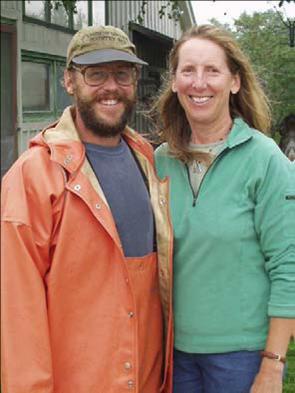eOrganic author:
Kim Stoner, The Connecticut Agricultural Experiment Station
Source:
Stoner, K., S. Gilman, S. Vanek, B. Caldwell, C. Mohler, M. McGrath, D. Conner, A. Rangarajan. 2008. Organic vegetable farms in New England: three case studies [Online]. Connecticut Agricultural Experiment Station Bulletin 1021. Available at:https://portal.ct.gov/-/media/CAES/DOCUMENTS/Publications/Bulletins/b1021pdf.pdf?la=en (verified 6 May 2019).
This article introduces three Northeast Organic Network farms that are more fully described in the source bulletin.
Kestrel Farm, Tom Harlow, Westminster VT
Tom Harlow produces sweet corn, lettuce, and winter storage vegetables, primarily for wholesale markets on his 50 cultivated acres. He identifies his crop mix, particularly the emphasis on winter storage crops, as critical to Kestrel Farm’s success. His crop mix allows him to spread labor, marketing, and cash flow over the year, and to reach out to wholesale markets over a large area. Another key feature has been his ability to recruit and keep skilled labor over several years in a difficult labor market. The labor supply is a concern for the long-term future, as is true for many farmers. His network of family, neighboring farmers, markets, and truckers is another critical factor, and the nearly ideal combination of deep, level, fertile, well-drained soils and abundant water for irrigation supports the production capacity of the farm. Focal Crops studied: lettuce, parsnips, butternut squash.

Farmer Tom Harlow. Photo credit: Kim Stoner, Connecticut Agricultural Experiment Station.
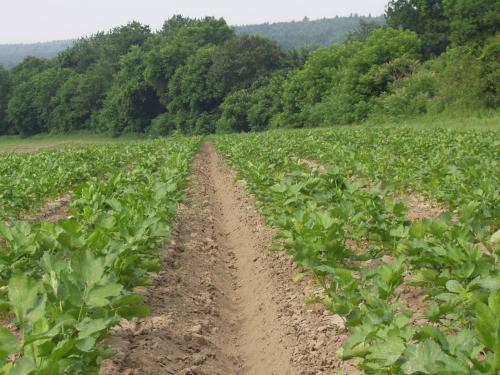
Parsnip field at Kestrel Farm after cultivation between the beds. Photo credit: Kim Stoner, Connecticut Agricultural Experiment Station.
Upper Forty Farm; Kathy, Ben, and Andy Caruso; Cromwell CT
Kathy Caruso’s dedication to finding, growing and marketing a huge diversity of the most flavorful and interesting vegetable varieties at upscale farmers’ markets in Connecticut is critical to the economic success of this farm, despite some production problems related to poor soil drainage. The Caruso family produces 99 varieties of tomatoes, 35 varieties of hot peppers, 18 varieties of potatoes, and successive crops of specialty snap beans, early season fava beans and, later in the year, edamame (edible soybeans) on only 3.5 cultivated acres. Focal Crops: snap beans, tomatoes, butternut squash.
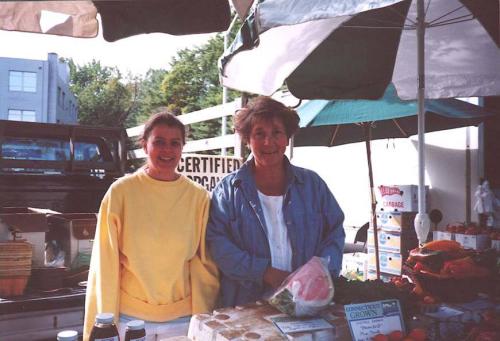
Farmer Kathy Caruso with a friend working at a farmer's market. Photo credit: Kim Stoner, Connecticut Agricultural Experiment Station.
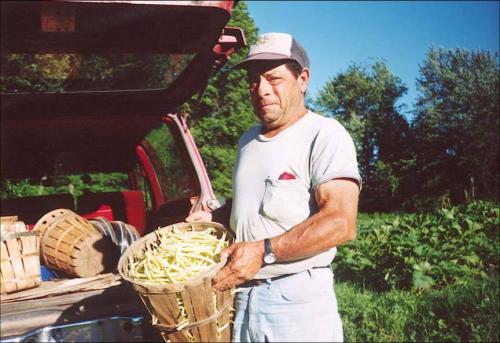
Ben Caruso harvesting beans. Photo credit: Kim Stoner, Connecticut Agricultural Experiment Station.
New Leaf Farm, Dave and Christine Colson, Durham, ME
The Colsons grow vegetables on only 1/4 to 1/3 of their 9.5 acres of cultivated land in any given year. The rest of the land is in a cover crop rotation, which is central to their strategy of building soil and managing weeds. The small area producing vegetable crops is intensively managed to produce high quality, high value crops, particularly salad greens, through a long season, from May to Thanksgiving. They market their produce locally to restaurants, natural food stores, and a CSA, and see their close relationship to their customers and community as critical to their success. They are also deeply committed to education about organic agriculture at all levels, including their local Waldorf school, their apprentices, the Maine Organic Farming and Gardening Association, and farmers throughout the Northeast. Focal crops: Brassica greens for salad mix, tomatoes, butternut squash.
Farmers Dave and Christine Colson. Photo credit: Kim Stoner, Connecticut Agricultural Experiment Station.
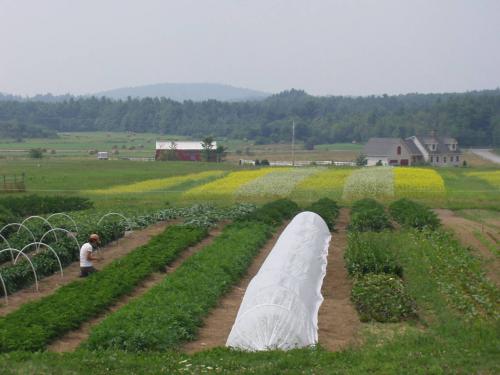
New Leaf Farm with row cover in foreground and a cover crop trial in background. Photo credit: Kim Stoner, Connecticut Agricultural Experiment Station.
